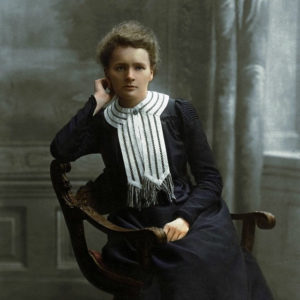Humanist Women in History: Marie Curie
March is Women’s History Month in the United States, the UK, and Australia. In commemoration we bring you the final installment in our five-part Humanist Women in History series. The first installment profiled Shirley Chisholm, the second Frances Fox Piven, and the third was about Priscilla Robertson. Last week we profiled Lisa Kalvelage and today we honor Marie Curie. There are so many important secular women in history, so tune in next March for more of their profiles!
“You cannot hope to build a better world without improving the individuals. To that end, each of us must work for our own improvement and, at the same time, share a general responsibility for all humanity.”
—Marie Curie
 Madame Curie, one of the greatest scientists of all time, was born Maria Sklodowska on November 7, 1867, in Warsaw, Poland—then occupied Russia. She was the daughter of two teachers: her freethinking father, a nationalist who taught physics and mathematics, and her Catholic mother, who ran a prestigious boarding school and died of tuberculosis when Maria was just ten years old.
Madame Curie, one of the greatest scientists of all time, was born Maria Sklodowska on November 7, 1867, in Warsaw, Poland—then occupied Russia. She was the daughter of two teachers: her freethinking father, a nationalist who taught physics and mathematics, and her Catholic mother, who ran a prestigious boarding school and died of tuberculosis when Maria was just ten years old.
Early on, Sklodowska was noted for her incredible memory and work ethic. At the age of fifteen she completed secondary school first in her class and received a medal for her outstanding academic work. However, because she was female, and Tsarist Russia was meting out reprisals for a nationalist uprising, Sklodowska wasn’t permitted to enroll in a university and so attended the illegal Flying University.
But in 1893 she was able to enroll at the world-famous Sorbonne in Paris where she met her husband, Pierre Curie, and adopted the French equivalent of her name (Marie). Her husband soon joined in her scientific investigations into the natural radioactivity discovered by another French scientist, Antoine Henri Becquerel.
It took Marie Curie only three years to earn degrees in mathematics and physics. In 1903 she presented the discovery of radium in her doctoral thesis. The examining committee expressed the opinion that her findings were the most important ever presented in such a forum. She became the first woman in France to complete a doctorate degree and later became the first woman to join the faculty at the Sorbonne.
In 1903, along with her husband and Becquerel, Curie was awarded the Nobel Prize in Physics for research into radioactivity. In spite of the tremendous sexism that nearly precluded her being awarded the prize, she became the first female Nobel laureate.
Despite the vast wealth it might have brought them, the Curies did not attempt to patent radium, instead allowing unhindered research access to the scientific community. “If our discovery has a commercial future, that is an accident. Radium is going to be of use in treating disease,” Marie said. “It seems to me impossible to take advantage of that.”
In 1911 Marie Curie was awarded the Nobel Prize in Chemistry for producing a pure metal sample of radium and establishing the atomic weight of radium and polonium. To this day she remains the only woman to have won two Nobel Prizes, the first of only two people to win Nobel Prizes in two different fields (the second was 1961 Humanist of the Year Linus Pauling), and the first of just four people to have won two Nobels.
At the onset of World War I, and although she despised war, Curie donated her and her husband’s Nobel Prize medals to the French war effort (Pierre had died an untimely death in 1906). She also pioneered the use of vehicles outfitted with x-rays or “mobile x-ray units” to help treat wounded soldiers.
On July 4, 1934, at the age of sixty-seven, Curie died of aplastic anemia, a blood disease that often results from radiation exposure. No doubt Curie, known to carry test tubes containing radioactive isotopes in her pocket, was exposed to massive amounts of radiation during her scientific career.
Curie is said to have become an agnostic as a teenager and was described variously throughout her life as a rationalist, an atheist, and a freethinker. “Nothing in life is to be feared,” she said. “It is only to be understood.”
